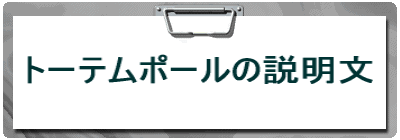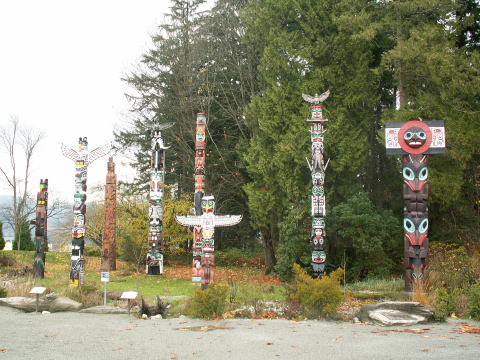

それぞれのトーテムポールには下記のような英文の説明が書かれています。

写真左から順に説明されています。いずれ翻訳してみたいと思っています。
****************************************************************************
1. OSCAR MULTIPI POLE <1st from the left>
First nations origin stories well of the animals and supernatural beings who helped found family lineages. These stories are celebrated in songs, dances and totem pole carvings. Kwakwaka’wakw artist Oscar Maltipi carved this pole in 1968. Originally from Turnour Island, Maltipi trained at the Royal B. C. Museum under artist and teacher Henry Hunt.
2. BEAVER CREST POLE <2nd from the left>
Carved in 1987 by Nisga’a artist Norman Tait along with his son Isaac, brother Robert, and nephew Ron Telek, this pole depicts how the Tait family’s Eagle clan adopted the beaver as their crest, and how the eagle and raven met and shared the sky.
“Once five brothers went to hunt heaver skins for a feast. The youngest brother helped the young beavers escape and followed them to their lodge. He watched as they took off their beaver cloaks to reveal human forms and tell of the death and destruction of their chief. He watched their songs and dances then returned home to report what he had seen. The brother performed the dances of the beaver people at a feast and raised a pole called Big Beaver. It was at this time that the Eagle Chief met and shared the skies with the Raven, which is another story.”
3. KAKASO’LAS <3rd from the left>
PEOPLE COME FORM FAR AWAY TO SEEK HER ADVICE
Kwakwaka’wakw carver Ellen Neel and her uncle Mungo Martin were among the first artists to achieve wide recognition for their totem poles commissioned by museums, cities, and art collectors. Neel was also the first woman to become a Northwest Coast carver. This pole was completed in 1955 for Woodward’s Department Store.
In memory of Neel’s pioneering role in reaching an international audience through her art, the University of British Columbia Museum of Anthropology has loaned this pole to Stanley Park.
4. CHIEF WAKAS POLE <4th from the left>
In Kwakwaka’wakw (Kwakiutl) ceremonies, carved staffs called talking sticks are held by people marking important speeches on behalf of a chief. This pole represents the talking stick and characters in an Owikeno story belonging to Chief Wakas. The original pole was raised in front of Chief Wakas’ house in Alert Bay in the 1890s. The raven’s beak opened to form a ceremonial entrance to the house, while the raven’s body was painted on the house front. Nimpkish artist Doug Cranmer, who has inherited Chief Wakas’ crests, carved this new pole in 1987.
5. SKY CHIEF POLE <5th from the left>
“Our art comes from spirituality. Even after the onslaught of another culture, our spirituality and our beliefs are alive. In this pole we wanted to acknowledge the arts and ceremonies of our grandparents’ generation and show that the arts are here today, just as we are here --- alive and intact.” Tim Paul
Hesquiat artist Tim Paul and Ditidaht artist Art Thompson carved this pole in 1988 to represent important characters in Nuu-chah-nulth history.
6. THUNDERBIRD HOUSE POST <6th from the left>
Carved house posts are used in traditional First Nations cedar houses to support the huge roof beams. This pole is a replica of a house post carved by Kwakwaka’wakw artist Charlie James in the early 1900s. Tony Hunt carved this replica in 1987 to replace the older pole now in the Vancouver Museum.
James experimented with colours and techniques creating a bold new style that has influenced generations of artists including his stepson Mungo Martin and granddaughter Ellen Neel. A pole by Ellen Neel stands to the left.
7. GA’AKSTALAS <7th from the left>
Ga’akstalas, carved by Wayne Alfred and Beau Dick in 1991, is based on a design by Russell Smith. The pole depicts many important figures in Kwakwaka’wakw culture. Red Cedar-bark Man is an ancestor who survived the great flood and gave the people the first canoe. The hero Siwidi, shown riding a killer whale, was taken under the sea to the home of the sea-world’s chief and brought back the right to use all of the sea-kingdom masks. The giantess dzunukwa sits at the base of the pole, symbolizing her central role in bringing magic and wealth to her people.
“We wanted this pole to be a beacon of strength for our young people and show respect for our elders. It is to all our people who have made contributions to our culture.”
Beau Dick, Ga’akstalas
8. CHIEF SKEDANS MORTUALY POLE <8th from the left>
An older version of this pole was raised in the Haida village of Skidegate about 1870. It honours the Raven Chief of Skedans and depicts the chief’s hereditary crests. The two tiny figures in the bear’s ears are the chief’s daughter and son-in-law who erected the pole and gave a potlatch for the chief’s memorial. The rectangular board at the top of the original pole covered a cavity that held the chief’s remains. Haida artist Bill Reid with assistant Werner True, carved this new pole in 1964. Don Yeomans recarved the top moon face in 1998.